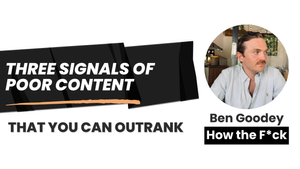Low link building budget? Do this.
In this week's newsletter, we'll look at three signals that show competitor content on the SERPs might be easy to outrank.
I always look for weaknesses like these in the top 5 search results when assessing whether I can win a keyword for a client.
If I see them, it usually means we can win with better content alone (i.e. no budget needed for link building).
Let's dive in.
1. Signal 1: Low Word Count
This one is slightly counterintuitive.
Word count is often not a good signal of quality (otherwise we could all just create lots and lots of fluff and it not be boring).
And it’s certainly not true that the highest-ranking article will always be the longest one.
However, if you have five blog posts in the top five SERPs that all have <500 words…it could be a strong indicator of an easy-to-win keyword.
Why?
Well, it’s hard to create a thorough guide to a topic in 500 words.
It’s very likely that the topic in question hasn’t been tackled in a complete way, leaving room for you to create better content.
It’s important to note that this isn’t a bulletproof method.
Product and services pages often rank well with only 300 words on the page.
Make sure top-ranked pages don’t have some other reason to be overperforming, like they have an extensive backlink profile or this is a branded query.
Do a quick check at content in the top 20.
Is there a 3,000-word blog post that’s pretty solid for this keyword that ranks at #15, despite the top 10 being 300-word service pages?
That should raise a red flag to investigate.
2. Signal 2: The SERPs Only Show Outdated Content
This one is a little more intuitive.
When you analyze the SERPs for a keyword, is the content up-to-date?
For example, is it 2024 and all the titles say 2022 or 2023? People are more likely to click an article with “2024” in the title than “2023”, and that matters.
This is a great opportunity to slide in with a better article.
No obvious title signifiers?
Go a little deeper and read the articles themselves.
- Do they provide accurate info?
- Is the information (like advice and statistics) up-to-date?
If all the top articles seems stuffy and old, this could be a great opportunity to satisfy a search need that nobody else has.
3. Signal 3: Poor Time to Intent
Some articles just take absolutely AGES to deliver on search intent (like 1500 words of waffle before getting to the answer people actually want).
Or they don’t do it very well (only a small section half-addressing the real intent, in a large guide that dances around the subject).
Those who have been following How the F*ck for a while will remember my Aura case study with Gaetano Dinardi.
One of the things we discussed as critically important (albeit based on our anecdotal experiences) to ranking well in Google.
He went as far as to say Introductionless Content would be the future of SEO. And I have to see, I agree that 99% of blog introductions are utter wastes of time—unless you can do them properly (listen to this podcast with copywriting pro Eddie Schleyner to improve your intro game).
With busy readers that are easily distracted, it’s key to get to the point as fast as possible. Address the search intent at the top.
Find content that doesn’t do this well?
That could be a good sign that your competitors have weak user experience signals. Do better, you might outrank them with ease.
—Benny
Missed the last two newsletters?
- "Low Intent Match" Method (How I Ranked Above Hubspot)
- Sneaking up on Competitors ("Lowest DR in Top 5" Method)


